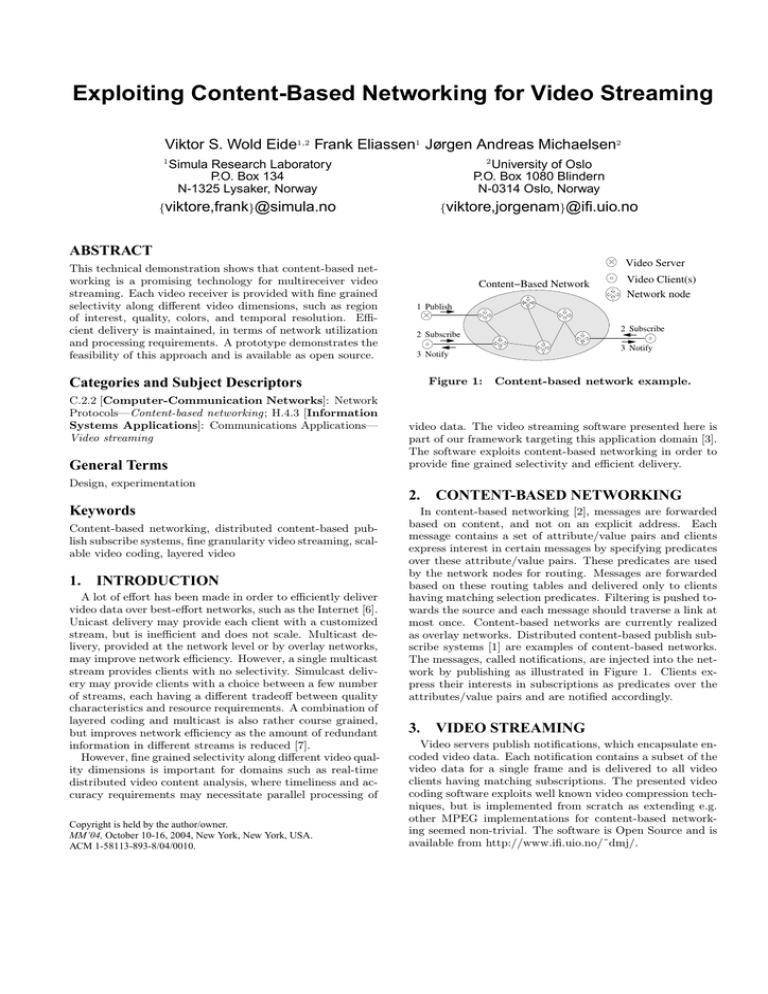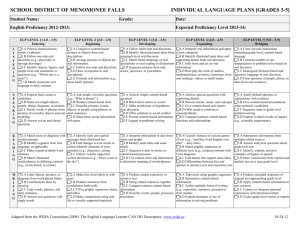Exploiting Content-Based Networking for Video Streaming Viktor S. Wold Eide Frank Eliassen
advertisement

Exploiting Content-Based Networking for Video Streaming
Viktor S. Wold Eide1,2 Frank Eliassen1 Jørgen Andreas Michaelsen2
1
2
Simula Research Laboratory
P.O. Box 134
N-1325 Lysaker, Norway
University of Oslo
P.O. Box 1080 Blindern
N-0314 Oslo, Norway
{viktore,frank}@simula.no
{viktore,jorgenam}@ifi.uio.no
ABSTRACT
This technical demonstration shows that content-based networking is a promising technology for multireceiver video
streaming. Each video receiver is provided with fine grained
selectivity along different video dimensions, such as region
of interest, quality, colors, and temporal resolution. Efficient delivery is maintained, in terms of network utilization
and processing requirements. A prototype demonstrates the
feasibility of this approach and is available as open source.
Video Server
Content−Based Network
01 Publish
Advertise
General Terms
2 Subscribe
2 Subscribe
3 Notify
3 Notify
Figure 1:
Categories and Subject Descriptors
C.2.2 [Computer-Communication Networks]: Network
Protocols—Content-based networking; H.4.3 [Information
Systems Applications]: Communications Applications—
Video streaming
Video Client(s)
Network node
Content-based network example.
video data. The video streaming software presented here is
part of our framework targeting this application domain [3].
The software exploits content-based networking in order to
provide fine grained selectivity and efficient delivery.
Design, experimentation
2.
Keywords
Content-based networking, distributed content-based publish subscribe systems, fine granularity video streaming, scalable video coding, layered video
1. INTRODUCTION
A lot of effort has been made in order to efficiently deliver
video data over best-effort networks, such as the Internet [6].
Unicast delivery may provide each client with a customized
stream, but is inefficient and does not scale. Multicast delivery, provided at the network level or by overlay networks,
may improve network efficiency. However, a single multicast
stream provides clients with no selectivity. Simulcast delivery may provide clients with a choice between a few number
of streams, each having a different tradeoff between quality
characteristics and resource requirements. A combination of
layered coding and multicast is also rather course grained,
but improves network efficiency as the amount of redundant
information in different streams is reduced [7].
However, fine grained selectivity along different video quality dimensions is important for domains such as real-time
distributed video content analysis, where timeliness and accuracy requirements may necessitate parallel processing of
Copyright is held by the author/owner.
MM’04, October 10-16, 2004, New York, New York, USA.
ACM 1-58113-893-8/04/0010.
CONTENT-BASED NETWORKING
In content-based networking [2], messages are forwarded
based on content, and not on an explicit address. Each
message contains a set of attribute/value pairs and clients
express interest in certain messages by specifying predicates
over these attribute/value pairs. These predicates are used
by the network nodes for routing. Messages are forwarded
based on these routing tables and delivered only to clients
having matching selection predicates. Filtering is pushed towards the source and each message should traverse a link at
most once. Content-based networks are currently realized
as overlay networks. Distributed content-based publish subscribe systems [1] are examples of content-based networks.
The messages, called notifications, are injected into the network by publishing as illustrated in Figure 1. Clients express their interests in subscriptions as predicates over the
attributes/value pairs and are notified accordingly.
3.
VIDEO STREAMING
Video servers publish notifications, which encapsulate encoded video data. Each notification contains a subset of the
video data for a single frame and is delivered to all video
clients having matching subscriptions. The presented video
coding software exploits well known video compression techniques, but is implemented from scratch as extending e.g.
other MPEG implementations for content-based networking seemed non-trivial. The software is Open Source and is
available from http://www.ifi.uio.no/˜dmj/.
Figure 2:
Experimental video client controller.
3.1 Fine Granularity Selectivity
Our video coding scheme supports selectivity along the
following dimensions: regional, quality, color, and temporal.
The smallest selectable region is a so-called superblock,
which is a number of 16 × 16 pixel macroblocks.
In the quality dimension, a layered coding is used. Each
block within a macroblock is transformed to the frequency
domain by using the Discrete Cosine Transform. The DCT
coefficients are quantized and bit-plane coded [5]. The different bit-planes are mapped to different quality layers. Notifications for the base layer contain the most significant bits.
With respect to colors, the luminance part of the video
signal is handled separately from the chrominance part and
sent in different notifications.
The temporal dimension is realized by a layered coding
scheme. The first frame in a gop (group of pictures) is intra
coded, i.e. self contained. The rest of the gop is coded to
exploit temporal redundancy. Only the difference between
two blocks is sent, taking the layering into consideration.
Each additional temporal layer, doubles the frame rate.
The maximum number of notifications generated pr. frame
is given by: #superblocks × #color layers × #quality layers. A 384 × 288 pixel frame and a superblock size of 8 × 6
macroblocks implies 3 × 3 superblocks, hence a maximum of
9 × 2 × 4 = 72 notifications/frame.
3.2 Description of Demonstration
This technical demonstration will show how different video
clients may subscribe to video data with fine grained selectivity. An experimental video client controller is shown in
Figure 2, illustrating a subscription and some statistics obtained during execution. Figure 3 shows how e.g. four different video clients may request different parts of the video
data (if unclear in the printed copy, please refer to the electronic version) - upper left: full quality and colors, lower
left: luminance and lowest quality for some superblocks,
upper right: luminance, chrominance, and both for different
columns, lower right: luminance and lowest quality, except
for a part in the middle having full quality and colors.
The content-based networking is handled by Siena [1], extended with IP multicast support [4]. The demonstration
will also show how the mapping from the “notification space”
Figure 3: Four video clients with different interests.
to IP multicast addresses may be changed during runtime.
Our Java implementation is capable of encoding/decoding
a 384 × 288 pixel video at 25 frames/sec. on a standard PC.
4.
CONCLUSION AND FURTHER WORK
Exploiting content-based networking for video streaming
has a potential for offering each video receiver with fine
grained selectivity along different quality dimensions, while
providing efficient delivery. We currently investigate how to
adapt to available resources by e.g. changing subscriptions.
5.
REFERENCES
[1] A. Carzaniga, D. S. Rosenblum, and A. L. Wolf. Design
and Evaluation of a Wide-Area Event Notification
Service. ACM Transactions on Computer Systems,
19(3):332–383, August 2001.
[2] A. Carzaniga, M. J. Rutherford, and A. L. Wolf. A
Routing Scheme for Content-Based Networking. In
Proceedings of IEEE INFOCOM 2004, Hong Kong,
China, March 2004.
[3] V. S. W. Eide, F. Eliassen, O.-C. Granmo, and
O. Lysne. Supporting Timeliness and Accuracy in
Real-time Content-based Video Analysis. In
Proceedings of the 11th ACM International Conference
on Multimedia, ACM MM’03, Berkeley, California,
USA, pages 21–32, November 2003.
[4] V. S. W. Eide, F. Eliassen, O. Lysne, and O.-C.
Granmo. Extending Content-based Publish/Subscribe
Systems with Multicast Support. Technical Report
2003-03, Simula Research Laboratory, July 2003.
[5] W. Li. Overview of Fine Granularity Scalability in
MPEG-4 Video Standard. IEEE Transactions on
Circuits and Systems for Video Technology,
11(3):301–317, March 2001.
[6] J. Liu, B. Li, and Y.-Q. Zhang. Adaptive Video
Multicast over the Internet. IEEE Multimedia,
10(1):22–33, Jan-Mar 2003.
[7] S. McCanne, M. Vetterli, and V. Jacobson.
Low-Complexity Video Coding for Receiver-Driven
Layered Multicast. IEEE Journal of Selected Areas in
Communications, 15(6):983–1001, August 1997.





